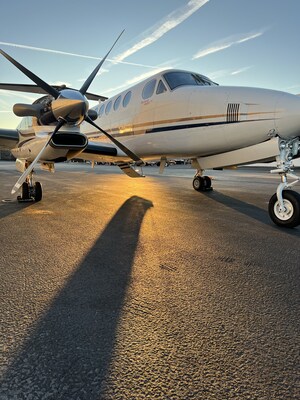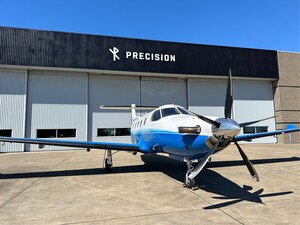SmartSky Defends Inflight Connectivity Patents from Gogo's Unlawful Infringement
Court Ruling Could Block Sale of "Gogo 5G" Immediately
RESEARCH TRIANGLE, N.C., Feb. 28, 2022 /PRNewswire/ -- SmartSky Networks filed a patent infringement lawsuit in U.S. Federal District Court in Delaware today that could block Gogo Business Aviation (NASDAQ: GOGO) from selling its "Gogo 5G" inflight Internet service and related hardware, which includes any required components (AVANCE L5, Gogo X3, and antennas). SmartSky also filed a motion for preliminary injunction, asking the court to immediately stop Gogo from making, using, and selling Gogo 5G while the infringement case proceeds. The complaint argues that after years of desperately trying to acquire more licensed spectrum, Gogo abruptly changed course and copied SmartSky's patented approach of using unlicensed spectrum to launch its new Gogo 5G inflight Internet service.
"It's now clear that Gogo is openly using our patented technology to mimic the service we launched last year in an effort to maintain its virtual monopoly for inflight connectivity," said SmartSky President Ryan Stone. "After Gogo lost its pre-emptive 2020 validity challenge to one of our now asserted patents, rather than take the high road, it instead brazenly proceeded with its Gogo 5G plans. Gogo is unlawfully attempting to use SmartSky's own inventions to stifle SmartSky's ability to enter the market and compete. We're asking the court to put a stop to Gogo's willful infringement immediately."
SmartSky's innovative air-to-ground (ATG) inflight Internet connectivity service offers high bandwidth and low latency that can support uninterrupted video conferencing, streaming video, and real-time aircraft monitoring services. Its network caters to the business aviation and regional jet markets and can deliver performance about ten times better than Gogo's legacy ATG service. To make this possible, SmartSky spent more than $100 million during the last decade developing and patenting a novel "beamforming" and "horizon-looking" technology that works in harmony with ground-based signals. These patented innovations enable the simultaneous use of the unlicensed 2.4 GHz radio frequency (RF) spectrum band, both on the ground and in the skies, without harmfully interfering with each other. The company also spent large sums deploying a new network on communications towers that will blanket the skies above the continental United States with coverage. SmartSky's technology portfolio is protected by more than 238 patents globally, including more than 100 patents granted by the U.S. Patent & Trademark Office.
According to technical analysis contained in the lawsuit, Gogo's infringement primarily focuses on the use of novel "beamforming" transmissions and software defined radio (SDR) techniques patented by SmartSky to operate in the unlicensed spectrum.
"In simplest terms, one patented innovation we created points narrow signals toward the horizon, whereas legacy ATG communicates more broadly into the sky. This enables the first effective ATG use of the 2.4 GHz unlicensed band, allowing us to employ 60 MHz of spectrum, twenty times that used by Gogo's aging ATG system," said Stone. "To do this, our technology uses complex configurations of radio towers, antennas, and radio beams precisely positioned and controlled by computers to ensure seamless handoff. The horizon-looking signals are sent in overlapping layers, like a cake, with one beam talking to one plane at a time for consistent high speeds, even at scale."
The lawsuit filed today outlines the detailed merits of the case, which asserts four specific SmartSky patents that Gogo's 5G service infringes:
- Beamforming Handoff. US Patent No. 9,312,947 ("the '947 Patent") describes using a software defined radio to implement a technique known as "beamforming" to direct narrow (beamformed) high speed radio signals continuously and uninterrupted to an aircraft from antennas mounted on a network of ground-based stations (i.e., seamless handoffs). In 2020, Gogo pre-emptively challenged the validity of this exact patent and lost, as the US Patent Office agreed with SmartSky and re-affirmed its validity. This patent claims priority back to 2005.
- Unlicensed Band Beamforming Handoff. US Patent No. 11,223,417 ("the '417 Patent") mirrors much of the '947 patent, but its patented claims are even more specific to the frequency band involved, covering the range from 2-6 GHz, which--by definition--includes the 2.4 GHz unlicensed band. This patent claims priority back to 2005.
- Horizon-oriented Architecture. US Patent No. 10,257,717 ("the '717 Patent") describes a network architecture where the radio signals are oriented toward the horizon instead of widely broadcast as previously done in legacy ATG technology, and which may combine licensed and unlicensed spectrum. This patent claims priority back to 2013.
- Harmonious Spectrum Reuse. US Patent No. 9,730,077 ("the '077 Patent) describes an over-lapping, "layered" architectural configuration of horizon-oriented signals that is created by placing a network of base stations apart from each other to ensure constant coverage over a wide area with an aircraft transmitting and receiving towards the horizon, as well, enabling the harmonious reuse of terrestrial spectrum in the air. This patent claims priority back to 2015.
"For many years, Gogo publicly dismissed the feasibility of unlicensed spectrum and focused entirely on satellite and air-to-ground in the licensed spectrum," said Stone. "It was only when SmartSky proved it had a significantly better, commercially viable product that Gogo shifted its attention to the unlicensed band and is now attempting to introduce its own long-promised network upgrade that's fundamentally based on SmartSky's patented technology."
According to expert economic analysis provided in the lawsuit, Gogo has held a virtual monopoly in business aviation and small regional jets for years. In 2021, Gogo had an 85% market share of the aircraft with connectivity in business aviation and 100% of the air-to-ground market in which SmartSky now competes. In 2020, Gogo sold its money-losing airline satellite business for $400 million so it could focus entirely on the more profitable business aviation and regional jet sector. Bolstered by this influx of capital and a refinancing of its debt, the lawsuit reveals that Gogo has been retooling its network of towers and antenna in ways that imitate those patented by SmartSky.
Stone added, "The whole point of a patent is to protect the intellectual property of an inventor. It ensures others cannot swoop in and use the fruits of the inventor's labor at will. Without this protection, innovation would be stifled, and big companies will always be able to muscle smaller competitors out of their market."
More information on the proceedings is available on SmartSky's website at: SmartSkyNetworks.com/patentlawsuit/.
About SmartSky
SmartSky Networks was founded to transform aviation through disruptive communications technologies, services, and tools. The network takes advantage of patented spectrum reuse, advanced beamforming technologies and 60 MHz of spectrum for significantly enhanced connectivity. SmartSky Networks uniquely enables an "office in the sky" experience with unmatched capacity for data transmissions both to and from the aircraft. This real-time, very low latency, bidirectional data link makes SmartSky Networks the best in-flight user experience, and a key enabler for new and enhanced applications and services. For more information, visit SmartSkyNetworks.com
Media Contact
For interview requests, further information, or high-res images, please contact:
SmartSky Networks, LLC
Brit Wanick, VP Marketing and Partnerships
T: +1 (800) 660-9982 ext. 729
SOURCE SmartSky Networks

WANT YOUR COMPANY'S NEWS FEATURED ON PRNEWSWIRE.COM?
Newsrooms &
Influencers
Digital Media
Outlets
Journalists
Opted In




Share this article